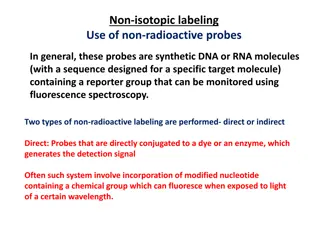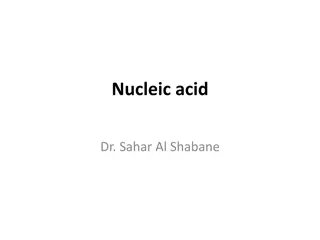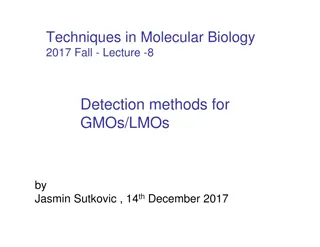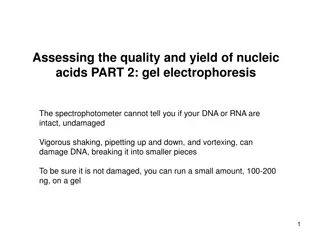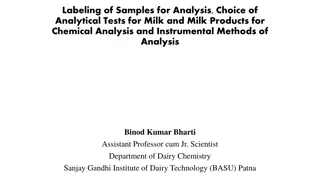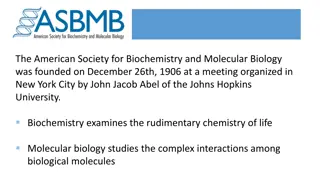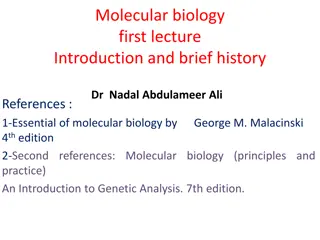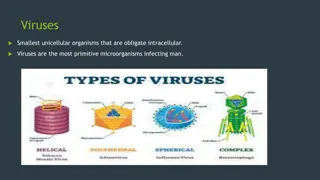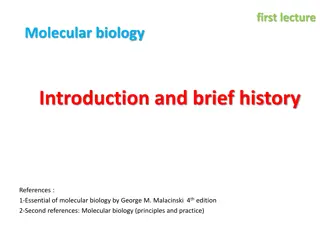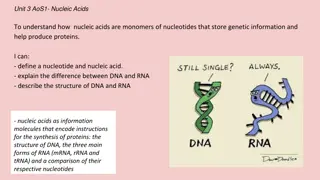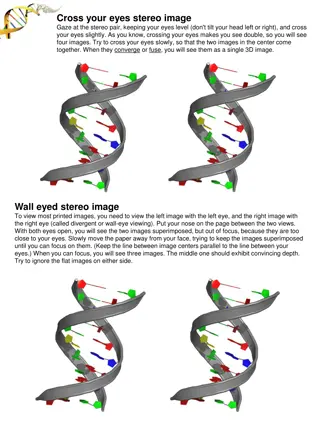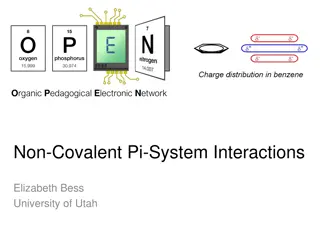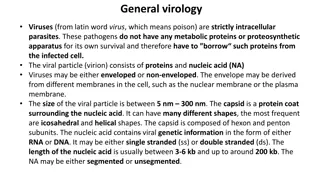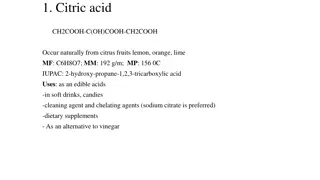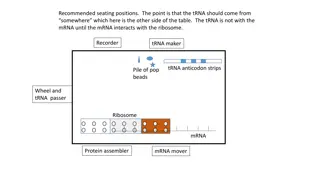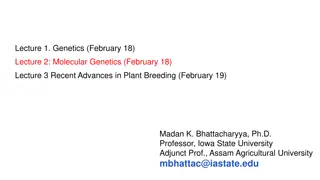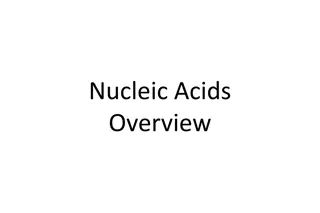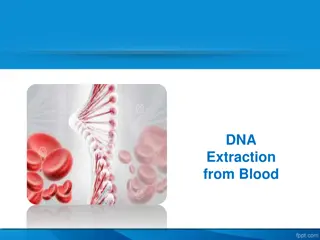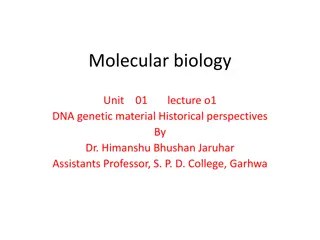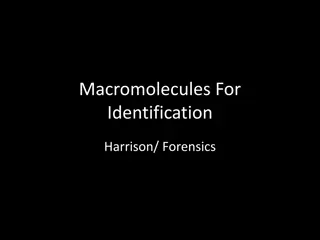Understanding Nucleic Acid Labeling and Detection in Molecular Biology
Nucleic acid labeling and detection play crucial roles in molecular biology, where hybridization helps identify complementary DNA or RNA sequences. Techniques like using labeled probes are essential for precise detection in complex nucleic acid mixtures. Understanding radioactive activity units and radioisotopes commonly used in biological research further enhances this process, ensuring accurate results in experiments involving DNA and RNA molecules.
Download Presentation

Please find below an Image/Link to download the presentation.
The content on the website is provided AS IS for your information and personal use only. It may not be sold, licensed, or shared on other websites without obtaining consent from the author. Download presentation by click this link. If you encounter any issues during the download, it is possible that the publisher has removed the file from their server.
E N D
Presentation Transcript
The SI unit of radioactive activity is the becquerel (Bq), in honor of the scientist Henri Becquerel. One Bq is defined as one transformation, decay, or disintegration per second. Since sensible sizes of radioactive material contain many atoms, a Bq is a tiny measure of activity; amounts giving activities on the order of GBq (gigabecquerel, 1 x 109decays per second) or TBq (terabecquerel, 1 x 1012decays per second) are commonly used. Another unit of radioactivity is the curie, Ci, it is equal, by definition, to the activity of any radionuclide decaying with a disintegration rate of 3.7 1010Bq, so that 1 curie (Ci) = 3.7 1010Bq. Counts per minute (cpm) is a measure of radioactivity. It is the number of atoms in a given quantity of radioactive material that are detected to have decayed in one minute. Disintegrations per minute (dpm) is also a measure of radioactivity.
Radioactivity measurement: Geiger-Muller counter (G-M Counter) The Geiger Muller counter (Gas based counter) is an instrument used for measuring ionizing radiation. It detects ionizing radiation such as alpha particles, beta particles and gamma rays using the ionization effect produced in a Geiger M ller tube. It is one of the best-known radiation detection instruments Readout: Count per second Absorbed dose
Radioisotopes which are commonly used in the biological research 32P, 33P, 131I, 35S, 14C, 45Ca, 3H
ATP, [-32P]- 1 mCi Perkin Elmer ATP, [ -32P]- 3000Ci/mmol 10mCi/ml EasyTide Lead, 250 Ci
Labeling and Detection of Nucleic acid In molecular biology, hybridization (is a phenomenon in which single-stranded deoxyribonucleic acid (DNA) molecules anneal to complementary DNA or RNA. or ribonucleic acid (RNA) Though a double-stranded DNA sequence is generally stable under physiological conditions, changing these conditions in the laboratory (generally by raising the surrounding temperature) will cause the molecules to separate into single strands. These strands are complementary to each other but may also be complementary to other sequences present in their surroundings. Lowering the surrounding temperature allows the single-stranded molecules to anneal or hybridize to each other. Nucleic acid hybrids can be formed between two strands of DNA, two strands of RNA or one strand of DNA and one of RNA.
Nucleic acid hybridization with a labeled probe is the only way to detect a complementary target sequence in a complex nucleic acid mixture. Nucleic acid probes are oligonucleotides or polynucleotides that can bind with high specificity to complementary sequences. Probes can be complementary to either DNA or RNA and can be from as few as 20 nt to hundreds of nt long. DNA probes RNA probes Oligonucleotide probes
Oligonucleotide probes are short stretches of single-stranded DNA or RNA used to detect the presence of complementary nucleic acid sequences (target sequences) by hybridization. In molecular biology, a nucleic acid probe is a fragment of DNA or RNA which can be radioactively or fluorescently labeled. These probes can be used of nucleotide sequences in are complementary to the sequence in the probe. to detect RNA the or presence DNA analyzed that The under alkaline conditions such as exposure to sodium hydroxide) into single stranded DNA (ssDNA) and then hybridized to the target ssDNA (Southern blotting) or RNA (northern blotting) immobilized on a membrane or in situ. labeled probe is first denatured (by heating or
DNA probes DS OR SS RNA probes SS Oligonucleotide probes SS 1. Heterologous Probe: Probe that is similar, but not exactly the same Mouse probe can be used to search a human genomic library. 2. Homologous: Probe that is exactly complementary to the nucleic acid sequence of interest
The labeling with radioisotopes or radioactive isotopes is called radiolabelling. Autoradiography
Label Location There are two ways to label a DNA molecule by the ends (end labeling) OR all along the molecule (uniform labeling) Uniform labeling: A. Nick translation The endonuclease DNase I is used to create nicks at random sites in the strand of double stranded target DNA DNA polymerase I is used to add nucleotide residues to the free 3 -hydroxyl ends created during the DNase I nicking process. As the DNA polymerase I extends the 3 -end, the 5 - tp 3 exonulecase activity of the enzyme simultaneously removes bases from the 5 -end of the nick. Sequential addition of bases on to 3 -end with the simultaneous removal of bases from the 5 -end results in translation of the nick Along the DNA molecule. DNA ligase
Pancreatic DNase I E. coli DNA polymerase I DNA ligase When performed in the presence of a radioactive ([ -32P]dNTP the newly synthesized strand becomes radioactivity labeled.
B. Random priming: This is an alternative method for preparing uniformly labeled DNA is by oligo-nucleotide primed DNA synthesis with hexanucleotide (or longer oligomers) of random sequences The klenow fragment is used as this enzyme lacks the 5 -3 exonuclease activity of DNA Polymerase I. It fills gaps between adjacent primers. Labeled nucleotides are incorporated Into new DNA that is synthesized.
B. 5-end labeling Alkaline Phosphatase T4 polynucleotide Kinase O
5'-end labeling for DNA we use gamma P, but it is alpha that is used at the 3' end?
MCQ Nucleic acids are readily labeled with tags that facilitate detection or purification. Which of the following components are required for the 3 - end labeling of DNA with radioactive phosphorous? (A) Terminal deoxynucleotidyl transferase and (gamma) 32P dNTP (B) Polynucleotide kinase and (gamma) 32P dNTP (C) Terminal deoxynucleotidyl transferase and (alpha) 32P dNTP (D) Polynucleotide kinase and (alpha) 32P dNTP


